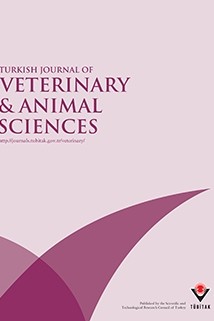
Turkish Journal of Veterinary and Animal Sciences
Yazarlar: Bilal DİK, Feyzullah GÜÇLÜ, Rifat CANTORAY, Suphi GÜLBAHÇE
Konular:-
Anahtar Kelimeler:Oribatid Mites,Fauna,Seasonal Density,Moniezia sp.,Turkey
Özet: This study was carried out to determine oribatid mite fauna,their seasonal fluctuations and the species which acts as intermediate hosts of anoplocephalid cestodes in the province of Konya. Soil samples were taken monthly from Bozkır, Ilgın, Karabağ, Karapınar and Yarma between September 1993 and September 1995. They were extracted with a modified Berlese-Tullgreen apparatus. The oribatid mites collected from the soil samples were preserved in glycerol until examination. Specimens were cleared in lactic acid before microscopic observation. Approximately 70,000 oribatid mite specimens were studied and found to consist of 56 species belonging to 34 genera and 22 families. Of these species, the following were new records for Turkey: Epilohmannia inexpectata, Hypochthonius rufulus, Allodamaeus starki, Oppia chitinophincta, Oppiella nova, O. ornata, Zygoribatula tenuelamellata, Z. longiporosa, Scheloribates fimbriatus,S.latipes, Eupelops acromios, E. torulosus, Euphthiracarus cribrarius, Protoribates monodactylus, P.obtusus, Ceratozetes mediocris, C.gracilis, Tectocepheus sarekensis, Oribatella meridionalis, O.berlesei, Suctobelba trigona,Suctobelbella subcornigera, S.sarekensis, Galumna kazakhstani, G.elimata, Pergalumna myrmophila, P.nervosa, and Pilogalumna boevi . The highest number of oribatid species was found in Bozkır and Yarma (28 species). Twenty-seven oribatid species were found in Ilgın, 25 in Karabağ and 23 in Karapınar. Oribatid mites were detected in all soil samples taken during the study. The annual dynamism of oribatid population density generally has two distinct maxima, in spring and autumn, with a deep depression during the summer. Spring peak abundance was the highest in March in Bozkır and Yarma, while in Ilgın, Karabağ and Karapınar it was highest in April. The maximum oribatid population density for autumn occurred in October in Bozkır and Yarma, and in September in Ilgın, Karabağ and Karapınar. The number of oribatid mites recorded for the first time in Turkey was very high. The number of oribatid species acting as intermediate hosts to Anoplocephalid cestodes as also significant. The cysticercoids of Moniezia sp. were observed in Xylobates lophotrichus and Zygoribatula cognata in the locality of Ilgın, and in Scheloribates laevigatus in the locality of Yarma.